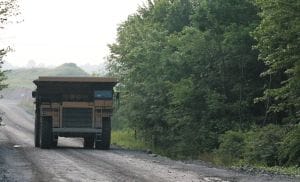Mining Feature: Fatigue Management for Haul Truck Drivers: A Low-Tech Solution for a Small Mine
Tuesday, October 28, 2014
To read the full journal article described in this feature, go to "Application of Fatigue Management Systems: Small Mines and Low Technology Solutions."
Out of an ongoing concern for the health and safety of its employees, a small family-owned surface mine in the northeastern U.S. has implemented a fatigue management system for its haul truck drivers. By capping the number of hours per week the drivers could work, consolidating the work schedule, and mandating breaks and vacation time, the mine reports an improved quality of life for employees and a positive impact on worker safety, with less emotional and physical stress and greater safety consciousness. Noting the success of this mine’s efforts, NIOSH researchers interviewed mine safety personnel in order to share the mine’s story as a case study.
As shown by NIOSH ergonomics research, haul truck drivers can suffer from increased levels of fatigue, musculoskeletal disorders, obesity and cardiovascular disease, and heightened stress. These factors have the potential to contribute to accidents and injuries. Haul roads at surface mines are structurally dynamic, with intersections and driving routes changing regularly to accommodate the shifting location of transported materials. Haul truck operators, who might drive between 6 and 10 hours each day, must also be aware of sudden drop-offs, be watchful of the patterns of other haul truck drivers using the same roads, and accommodate muddy or icy conditions.
At the studied surface mine—a sand, stone, and gravel operation working the same quarry for five decades—the fatality of a haul truck driver in the 1990s led mine management to undertake targeted safety improvements. Initially, the haul roads were widened, the berms were made higher and set further back, and “best practices” procedures were developed. As part of these changes, a reverse driving pattern was implemented on the haul roads, allowing the operator to use the left side of the road rather than the right so the berm of the road could be seen from the cab. In addition, a safety committee was formed, including representatives from management, safety personnel, and the mining workforce. The safety committee was empowered to develop and present ideas for the benefit of all mine employees. Among these ideas was equipping the vehicles at the mine site with rear vision cameras.
Over the next decade, as it became clear that some employees were showing signs of fatigue, senior staff and mine safety personnel decided to widen the Federal Motor Carrier Safety Administration (FMCSA) hours of service rule to include all employees at the mine. This rule’s objective is to reduce long work hours that increase the risk of fatigue-related crashes and long-term health problems for drivers. Consistent with FMCSA standards, the number of hours employees were permitted to work each week was capped at 60. Instead of running three work shifts, the mine consolidated the schedule so that all employees worked the day shift. Mandated breaks were also implemented, with stretching and moderate exercise promoted during these breaks. Finally, instead of allowing employees to work through vacation time in exchange for compensation, the vacation policy was changed to a “use it or lose it” approach, with a requirement that all of the miners take vacation time each year.
Though the above fatigue management system took years to implement and included some financial costs, it directly improved the quality of life for employees both at work and at home, and the specific changes to the haul road operations had a direct impact on worker safety. The mine safety personnel interviewed by NIOSH as part of this case study stressed that the success of the program was grounded in accounting for mine-specific needs, the cooperative relationship between mine management and employees, and the commitment to protecting each worker at the mine—one life at a time.
- Acceleration and GPS Data Monitor Truck-Haulage Jolts
- Application of Fatigue Management Systems: Small Mines and Low Technology Solutions
- Characteristics of Fugitive Dust Generated from Unpaved Mine Haulage Roads
- Develop Mining Fatigue Model and Management System
- Emergency Response Planning for Small Mines: Who Needs It?
- Evaluation of Devices to Prevent Construction Equipment Backing Incidents
- Programmable Electronic Mining Systems: Best Practice Recommendations (In Nine Parts): Part 2: 2.1 System Safety
- Programmable Electronic Mining Systems: Best Practice Recommendations (In Nine Parts): Part 8: 6.0 Safety File Guidance
- Test Results of Collision Warning Systems for Surface Mining Dump Trucks
- Tying Acceleration and GPS Location Information Together To Create a Mine Management Tool
